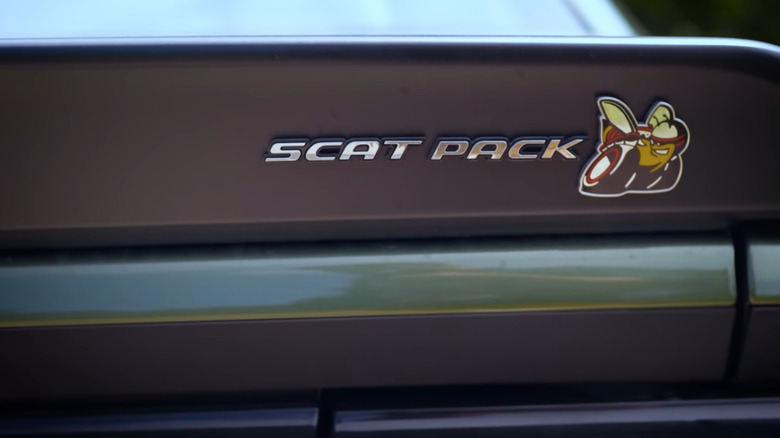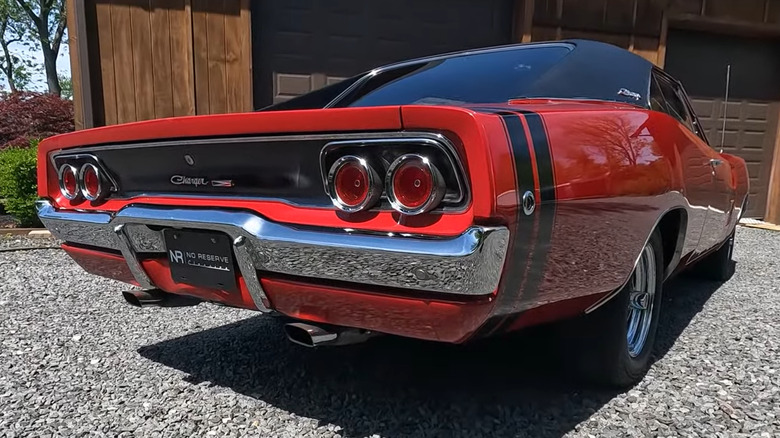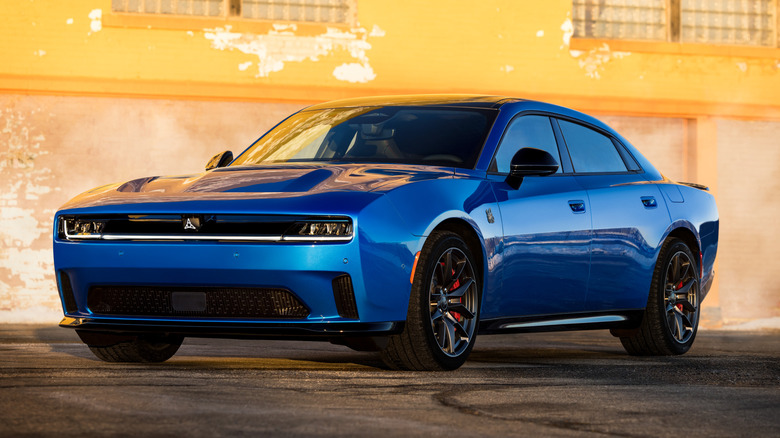What Does Dodge's 'Scat Pack' Designation Mean?
Ever thought about what goes behind automotive branding? Most of the time, brand names help build character — think of the Dodge Demon or Lamborghini Diablo. These names are a dead giveaway about what to expect on the spec sheet. Throughout its history, Chrysler had a knack for capturing the imagination through its clever branding. The now-discontinued Hellcat badge on a Dodge Challenger, for example, serves as a subtle warning, signaling that the car is packing a supercharged 6.2-liter HEMI and isn't to be taken lightly.
One of the most iconic Dodge names among American muscle enthusiasts is the "Scat Pack." But what does it mean? Well, if you are a music fan, "scat" is a type of melodic jazz singing, which can be a little confusing when associated with a muscle car. It's also a term for poop. However, in automotive circles, it's more than either. It is a heritage-filled badge that dates back to 1968.
The "Scat Pack" name is a creative variation on Frank Sinatra's Rat Pack from the 1950s, possibly combined with "scat" in the sense of asking someone "get lost", "move fast," or "get outta here." It originally signified a group of Dodge performance cars, including the popular Charger R/T, Coronet, and Dart GTS, that were quick on their heels, running under 14 seconds on the quarter mile.
The history behind the Scat Pack name
There's a lot that went into the "Scat Pack" name. For starters, it all began as an advertising campaign by Detroit Ad agency Ross Roy. But Chrysler wasn't the only automotive outfit coining cool names for its cars. During that era, Ford had its own "Total Performance" strategy that focused on motorsport dominance, while Chevy had the Super Sport (SS) program. However, what drew more attention to Chrysler was what it offered: exclusivity.
Unlike Chevrolet, which offered the SS badge on a wide range of vehicles with different powertrains, Dodge reserved the Scat Pack badge for its most potent performance cars — the Dodge Charger R/T, Coronet R/T, Dart GTS, and later on, the Super Bee. All early Scat Pack cars featured the "bumblebee" stripes that went around the trunk lid. And as you'd expect, during that time, any Dodge car with the hallowed bumblebee stripes meant it was packing some serious heat.
One of the most iconic members of this early Scat Pack family was the 1969 Dodge Super Bee. This was by all means already a good-looking muscle car, but according to period Dodge dealer literature, Dodge made it even more appealing by offering it with Scat Pack upgrades that included functional hood scoops, chrome hood hold-down pins, three-speed windshield wipers, performance tires, and optional vinyl roofs. Dodge wanted young buyers inquiring about the Super Bee to know that they weren't just buying a car, but an identity.
Evolution of the Scat Pack name
Dodge used the Scat Pack name from 1968 until 1971, when it was discontinued. After close to half a century of silence, though, Dodge revived the Scat Pack name at the Specialty Equipment Market Association (SEMA) show in 2014. The following year, it launched the Scat Pack as a trim for revived Dodge Chargers and Challengers. By the end of the gasoline-powered Charger and Challenger's lifetimes, the Scat Pack would refer to a mid-tier performance package that sat between the R/T and Hellcat trims.
The Scat Pack Charger and Challenger featured a 6.4-liter 392 HEMI V8 engine capable of making 485 hp and 475 lb-ft of torque. The cars came with a host of add-ons, including enhanced Brembo brakes, more aggressive styling, and the iconic badging. The heritage-filled moniker has even transitioned into the electric vehicle era and is the top-end trim for the Dodge Charger Daytona EV. The name has truly evolved from a marketing campaign to a bona fide badge in Dodge's performance lineup.


